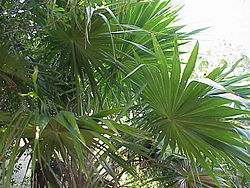Thrinax
| Habit | palm-cycad
| |
|---|---|---|
| Lifespan: | ⌛ | perennial |
| Exposure: | ☼ | sun |
|---|---|---|
| Features: | ✓ | evergreen, foliage |
|
Thrinax > |
If this plant info box on watering; zones; height; etc. is mostly empty you can click on the edit tab and fill in the blanks!
Thrinax is a genus in the palm family, native to the wider Caribbean. It is closely related to the genera Coccothrinax, Hemithrinax and Zombia.[1] Flowers are small and bisexual, and are borne on small stalks.
Read about Thrinax in the Standard Cyclopedia of Horticulture
|
|---|
|
Thrinax (Greek, fan). Palmaceae, tribe Corypheae. Thatch Palm. Fan palms well adapted for pot culture. Spineless palms: trunks low or medium, solitary or cespitose, ringed below, clothed above by the fringed lf .-sheaths: lvs. terminal, orbicular or truncate at the base, flabellately plicate, multifid; segms. induplicate, bifid; rachis short or none; ligule free, erect, concave; petiole slender, biconvex, smooth on the margins; sheath usually beautifully fringed: spadices long; axis clothed with tubular sheaths, papery-coriaceous, split: fls. perfect, the calyx and corolla united into a lobed or entire cup, on rather long, slender pedicels, the pedicel with a caducous bract at the base; stamens 6, their filaments united below; ovary 1-celled: fr. the size of a pea.—About 17 species, native to W. Indies and Fla., and not much known in cult. For the new Porto Rican species, see Cook, Bull. Torr. Bot. Club, Oct., 1901 (vol. 28). Upon a technical embryo character some of the species below and many other wild species are segregated to constitute the genus Coccothrinax, Sargent. As that genus does not differ horticulturally, these species are here treated with Thrinax. See Coccothrinax. The species are of slow growth, but succeed with indifferent care. They are mostly of elegant form and habit. A good specimen is shown in Fig. 3794. Other species of Thrinax are in cult. in private collections (see p. 2446), but it is doubtful whether they are in the trade. Some of them may be listed as Coccothrinax. T. altissima, Hort. Lvs. large, 4 1/2 ft. diam., nearly orbicular, the upper lobe of the base folding over the lower one some 7 or 8 segms., rich glossy green above, brilliant silvery beneath, with about 58 segms. which reach over one-third of the way to the base; ligule deep buff-orange, subreniform, open at base: a small basal area of the lf. orange-tinted; petioles 4 1/2 ft. long, biconvex, slightly channeled above, bases included in a closely woven network of strong fiber, greenish yellow, the fiber ashy brown. Grows with vigor in Fla., on ordinary pineland. The botanical position of this palm is undetermined. —T. argentea, Chapm. –Coccothrinax.—T. Chuco-Acanthorrhiza Chuco.—T. crinita, Griseb. & Wendl. Cuban. A moderate-sized palm with lvs. about 3 ft. diam., and with a short, stiff ligule. Probably belongs, according to Beccari, somewhere near Coccothrinax argentea. This palm was lost to science for 60 years and has recently been rediscovered. A specimen growing in the Brooklyn Botanic Garden has the trunk covered with a fibrous hair-like growth, unlike any W. Indian palms known.—T. elegantissima, Hort., seems to be unknown to botanists. It may be T. elegans which probably belongs to T. radiata.—T. floridana, Sarg. A slender tree, to 30 ft.: lf.-blades 3-4 ft. across, yellowish green, shining above: spadix 3-4 ft. long: fls. slender-pedicelled, the sepals and petals united; filaments subulate: fr. small, 1/2 in. diam. or less. Fla. and Keys.—T. Garberi, Chapm. - Coccothrinax.—T. keyensis, Sarg. Rather stout, 25 ft., the trunk on a base of matted roots: lf.-blades 3-4 ft. across, yellowish green above: spadix 6 ft. or so long: fls. on short disk-like pedicels, and sepals and petals only partly united; filaments triangular: fr. 1/4 in. or less thick. Lower Keys.—T. microcarpa, Sarg. Tree, 30 ft. or more: lf.-blades 3-4 ft. broad, pale green above and silvery white beneath: spadix 1-2 ft. long: fls. on disk-like pedicels, the sepals and petals only partially united: filaments triangular: fr. very small, only 1/6 in. or less thick. Keys of Fla.—T. Morrisii, Wendl. One to 2 1/2 ft. high: lvs. glaucescent beneath; segms. free for about two-thirds or three-fourths their length. G.C. III. 11:113; 30:353. Anguilla.—T. Wendlandiana, Becc. Lvs. flabellate-orbicular, paler beneath; segms. linear-oblong: spadix elongated: fls. long-pedicelled. Cuba and Honduras. CH
|
Cultivation
- Do you have cultivation info on this plant? Edit this section!
Propagation
- Do you have propagation info on this plant? Edit this section!
Pests and diseases
- Do you have pest and disease info on this plant? Edit this section!
Species
Thrinax consists of four species. Three of them are single-island endemics - Thrinax ekmaniana is exclusively endemic to hills Mogotes de Jumagua, Cuba while Thrinax excelsa and Thrinax parviflora are endemic to Jamaica. The fourth species, Thrinax radiata, is more widespread - it is present in the Greater Antilles, the Bahamas, south Florida, Mexico and Central America.wp.
Thrinax morrisii was renamed Leucothrinax morrisii in 2008wp.
Gallery
If you have a photo of this plant, please upload it! Plus, there may be other photos available for you to add.
References
- Standard Cyclopedia of Horticulture, by L. H. Bailey, MacMillan Co., 1963
External links
- w:Thrinax. Some of the material on this page may be from Wikipedia, under the Creative Commons license.
- Thrinax QR Code (Size 50, 100, 200, 500)
- ↑ Henderson, Andrew; Gloria Galeano; Rodrigo Bernal (1995). Field Guide to the Palms of the Americas. Princeton, New Jersey: Princeton University Press. ISBN 0-691-08537-4

